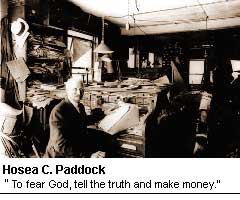February 06, 2003
Bigger is Better (Duh!)
 You just have to love Hosea C. Paddock. When H.C., as his descendants call him, went into the newspaper business 120 years ago, he forthrightly proclaimed his intentions with this slogan: "Our aim: To fear God, tell the truth and make money."
You just have to love Hosea C. Paddock. When H.C., as his descendants call him, went into the newspaper business 120 years ago, he forthrightly proclaimed his intentions with this slogan: "Our aim: To fear God, tell the truth and make money."
Now, I can take or leave the God part (but giving our president's affinity for the Big Guy - "The liberty we prize is not America's gift to the world; it is God's gift to humanity." - maybe I should rethink that position), however, the rest of H.C's motto represents my kind of thinking.
The little paper H.C. Paddock started in a Chicago suburb grew into the Daily Herald, the third-largest paper in Illinois and one of the nation's most abundantly staffed.
Mark Fitzgerald of Editor & Publisher reports that the 149,000-circulation Herald "maintains a newsroom that is nearly twice the industry average -- and disputed rule of thumb -- of one full-time equivalent (FTE) for each thousand in circulation."
Why? Douglas Ray, CEO of Paddock Publications says so-called "overstaffing" is an "essential part of how we do business here."
"If you have a long-term stake in a market," Ray says, "you have to cover the communities intensely. You can't do that with smoke and mirrors -- it takes people to do that."
And is this way of thinking good for business? Ray says the company "could be much more profitable than we are today" but that would undercut its larger goal. "The paper has had 21 years of circulation growth without missing an ABC [Audit Bureau of Circulations] reporting period. It takes a number of people to do that."
The 1-to-1,000, newsroom-to-circulation metric has a specious history, and, according to Lori Robertson, managing editor of the American Journalism Review, who looked into the origins of this rule of thumb and found them elusive, is widely criticized by newspapers executives and newsroom managers alike.
"It's been called an industry standard, the norm, an average and a rule of thumb. It's also been called a myth, folklore and flat-out wrong. Yet it's often cited--even if it's being derided--and widely known by most in the newspaper business."
It's wrong, indeed, Rick Edmonds, a researcher for the Poynter Institute, told Robertson. He said the industry norm is now about "1.2 to 1.4 or so FTEs per every 1,000 in circulation."
(Edmonds was also involved in a project by Poynter and the Project for Excellence in Journalism that found the 218,000-circulation Fort Worth Star-Telegram to be the "best-staffed paper in America" - 370 FTEs.)
The unanswered questions in both Edmonds' study and Robertson's story, though, are these: What are all those FTEs doing? Are they reporting? Are they writing and editing stories? Or are they processing pages and performing other pre-press functions that once belonged in the mysterious realms of the backshop but were brought by technological changes into the newsroom?
(Please, copy editors, call off the posse! I mean no disrespect to the wordsmiths and paginators on the desk, but, let's face it, without the reporters and their stories there is nothing to wordsmith or paginate.)
Few media magazines have a more conservative editorial philosophy than Editor & Publisher. It is, after all, a trade publication whose revenue depends on the very institutions it is covering, so criticism and coverage of sensitive issues is handled gently. It is a good sign, then, that the cover story in this week's issue is "The Missing Link Between Quality and Profits." Maybe the industry is starting to wake up.
Links
![]() Editor & Publisher Some Publishers Believe in Big Newsrooms
Editor & Publisher Some Publishers Believe in Big Newsrooms
![]() Editor & Publisher The Missing Link Between Quality and Profits
Editor & Publisher The Missing Link Between Quality and Profits
![]() American Journalism Review Rule of What?
American Journalism Review Rule of What?
![]() Poynter Institute The Best-Staffed Newspaper in America
Poynter Institute The Best-Staffed Newspaper in America
Paddock's slogan is my favorite!
Posted by: Meg on February 6, 2003 11:53 PM